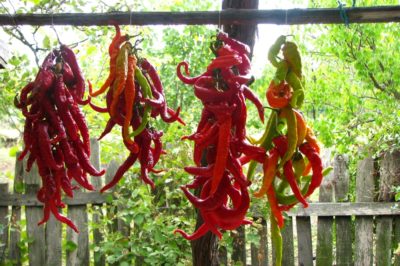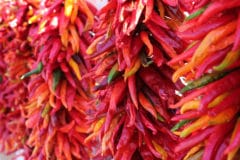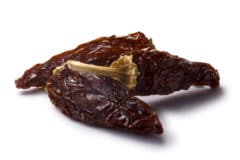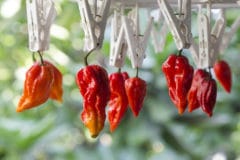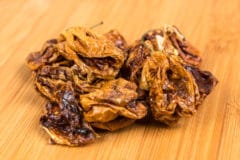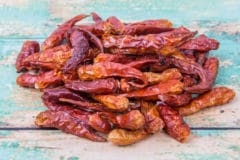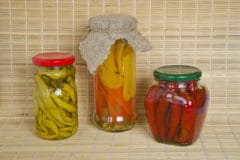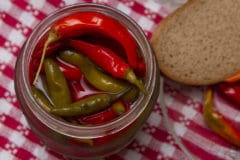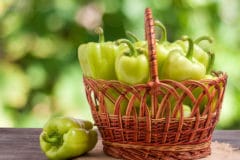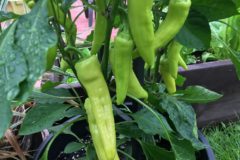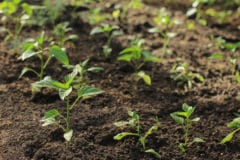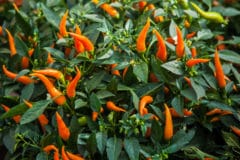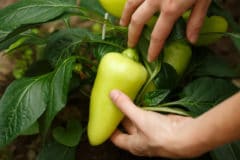Hot vs. Sweet Peppers
When you dry a pepper the flavor and the heat of it is enhanced. With no moisture, the volatile oils, sugars, and capsicum concentrate and magnify. Because dried pepper is more intense than fresh peppers, you only need to add a fraction of the amount to achieve the same flavor and fire in any recipe.
Are hot peppers the only ones you can dry? Not by a long shot. The sugars in sweet peppers concentrate creating a tart and sweet powder similar to paprika. Paprika is actually the dried crushed powder of sweet bell peppers. Don’t hesitate to dry your sweet peppers right alongside your hot peppers.
When working with large amounts of hot peppers the capsicum can become airborne. This floating fire causes eye, nose, mouth, and skin irritations. While capsicum cannot actually damage tissue, over-exposure to spicy peppers is severely uncomfortable. Process hot peppers in a well-ventilated space.
If you are in your kitchen, leave the windows open and have a fan running. Wear gloves when working with hot peppers and avoid transferring capsicum to other parts of the body through scratching or rubbing your eyes.
Preparing Peppers
Go through your peppers one by one. Wash each of them in warm water and then place them on a towel to dry. As you wash them, inspect each fruit for signs of rot, mushiness, disease spots, or off odors. Imperfect peppers won’t dry properly and should be discarded. You can use those fruits for a fresh recipe and just cut out any damaged areas.
The peppers that will be dehydrated should be completely dry before beginning the next step. Excess water on the fruit can cause it to go mushy instead of hardening while drying. Allow them adequate time to dry, or dry them off with a towel.
Whether you choose to slice them depends on your preference and the method of dehydration. There are three common methods for drying peppers:
- In the oven
- In a dehydrator
- In the open air
Peppers dried in the oven are often sliced beforehand to quicken the process. It is popular to remove the stem and slice them lengthwise in half.
If dehydrating in the open air, you may choose to leave them whole. Whole peppers dry slowly but do not run the risk of acquiring any bacteria while dehydrating. Drying sliced peppers in the air may allow rot to turn them mushy.
In The Oven
There are advantages and drawbacks to dehydrating peppers in the oven. It is convenient to use a household oven for this process. No special equipment is required, and it can be done just about anywhere.
Peppers ripen during the heat of summer. This is just about the time that you do not want an oven heating up the house for a day or two. Depending on humidity, the oven temperature, and the size of the peppers it can take up to three days. Using an oven does not give you the control over the process that a dehydrator would, and temperatures can be off sometimes. If not monitored diligently you may end up with cooked peppers or fruit that didn’t quite dry enough.
To dehydrate peppers in the oven simply lay them on a cookie sheet in a single layer. Typically peppers are halved lengthwise when drying in the oven. It is up to you how you choose to slice them. Seeds can be left to dry with the pepper or removed according to preference. The seeds tend to be the hottest parts of the fruit so take extra care when handling them. Avoid allowing fruits to touch each other. This will prevent them from drying completely.
Turn your oven onto the ‘warm’ setting. Different ovens have different warming temperatures usually somewhere between 150-200°F (65-93°C). The ideal drying temperature for peppers is between 120-150°F(48-65°C). Monitor them for signs of blackening or softening. This means that your peppers are cooking, not dehydrating, and the temperature needs to be reduced.
If your oven is on the lowest setting already but the peppers still seem too hot, crack the oven door to allow some heat to escape. This process can take anywhere between one and three days. Move them around on the cookie sheet several times to ensure even drying. They are done when fully dry and crisp with no hint of chewiness.
In A Dehydrator
Dehydrators come in all shapes and sizes. You can get a small electric countertop dehydrator for fairly inexpensive. Larger ones cost more but feature more space and control options.
Or, build a solar dehydrator from wood scraps and an old window. Solar dehydrating requires sunlight and is less controllable than electric dehydrating. However, solar dehydrators can hold a lot more product than household dehydrators and they offer advantages to sun-drying including a far faster drying time and less discoloration.
Peppers that are larger than 1-inch in length should be sliced. Smaller ones can be left whole. Place them evenly on the dehydrator shelves in a single layer with none touching. They should be left in the dehydrator for between 8-12 hours. If your dehydrator can be adjusted for temperature, set it at 135-145°F(57-62°C).
This tool is made for drying foods from greens and herbs to fruits and vegetables. Don’t stop at your peppers, utilize it all year long to preserve your garden bounty.
Hang-drying
Hang-drying is the traditional method for drying peppers and works exceptionally well in warm and dry climates. You can do this in a warm kitchen or outdoors under a covered area. Keep in mind that moisture from weather patterns and humidity will affect the drying fruit so only do this during dry seasons.
To hand-dry, leave peppers whole with their stems intact. You will need a string or line of some kind. Fishing line works well, or any kind of garden twine or string. Using a needle or other sharpened straight object, you will thread the line through each of the pepper stems. With the line attached to your needle, go through the pepper stem and then tie a knot to hold the pepper in place.
Repeat this process for each pepper. Spread them out for maximum airflow. You are not creating those beautiful ristas or sprays of dried peppers, though you can make those once the fruit is dry. Adequate space between each pepper is necessary. They may take up to two weeks to fully dry.
Sheet Drying
This is the simplest method for dehydrating peppers, also called sun-drying. It does take up some space, but can be done inside or outside in warm regions. peppers can be sliced or left whole, it is up to you. Spread them out on a tarp, sheet, or trays one layer thick so none of them touch. Placing them in a sunny area is ideal. Drying them outside in the sun can take the least amount of time. But an indoor area that is dry with good ventilation will work too.
If you sliced the peppers and are drying them outside, they may need some protection from insects. Place a screen over the fruit to prevent flies or other bugs from landing on the fruits.
Storage and Processing
When your fruit has dried completely, they should be crisp and not fleshy in any way. Different methods will preserve the colors better than others, so don’t be discouraged if they’ve lost a bit of color during the process the flavor isn’t affected.
You can store them as-is in sealable plastic bags or containers. You can also process them into flakes or powder. Flakes are a popular condiment for pizzas and other dishes that you want to spice up. The powder is useful for adding to just about any recipe. You are essentially making your own chili pepper powder, cayenne, or paprika depending on what type of pepper you are drying.
Store flakes or powders in small spice jars for easy sprinkling and label them clearly so you know which are hot. Home dried peppers make festive and colorful gifts for friends and family.
